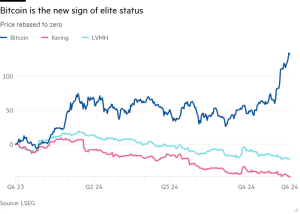Young women are starting to leave men behind
Unlock the Editor’s Digest for free
Roula Khalaf, Editor of the FT, selects her favourite stories in this weekly newsletter.
Across the developed world, girls and young women have been pulling ahead of boys and young men in education for several decades, with much larger proportions going on to attend university than their male counterparts.
This trend has generally been treated more as something to remark upon than to act on. The myriad domains in which women remain at a disadvantage to men have understandably led to efforts at achieving gender equality becoming synonymous with advancing women’s opportunities and outcomes. Men have always gone on to have better labour market outcomes anyway, and if women outperform men in education, this helps narrow the overall male advantage — or so the thinking has gone.

The problem with this framing is that in an increasing number of countries, we have moved beyond a narrowing gap in socio-economic outcomes, and there is now a new and growing gap in the opposite direction.
Much less appreciated than the widening tertiary education gap is the fact that in several rich countries young women are now more likely to be in work than young men. The UK joined this group in 2020, and the female employment rate lead among 20-24s has since widened to three percentage points. The crossover is yet to happen in the US, but young women’s employment rate deficit has shrunk from almost 10 percentage points in 2006 to a single point last year.

Put another way, the UK is part of a growing list of countries where the answers to “who is doing most of the legwork raising children?”, “who is focused on getting a good education?” and “OK, but who is out working to bring home a good income?” are all: “Women.”
If this were simply a case of women making strides, it would be something to celebrate — and that side of the story certainly is — but a substantial minority of young men are actively moving backwards, with growing numbers increasingly disengaged from society.
Across the developed world, the portion of young men who are neither in education, in work nor looking for a job has been climbing steadily for decades. In countries including the UK, France, Spain and Canada there are now more young men than women in effect outside the economy for the first time in history. Unlike young women, these men are generally not occupied by caring for other family members either. They are adrift and likely to be the ones in need of care themselves. More than 80 per cent of this group in the UK report long-term health problems.

Perhaps most striking of all, 2022 was the first time the average young woman in the UK had a higher income than her male counterpart. This is due in large part to women becoming so much more likely to have a degree and the graduate salary that comes with it, but also to the deteriorating fortunes of non-graduate men, who have gone from earning 57 per cent more than non-graduate women in 1991, to 10 per cent less in 2022.

It is a similar story in the US, where young non-college women and college-educated people of both sexes have all seen incomes either hold up or increase, but non-college men have plummeted down the income distribution.
While shifting composition plays a role here — today’s non-college graduates are a very different group to non-graduates 30 years ago — it cannot explain the starkly different trajectories of non-college men and women, which owe more to the continuing transition from an economy where jobs requiring hands, hearts and heads were all plentiful and relatively remunerative, to one where the latter dominate.

But while discourse and policy remain focused on other things, the repercussions of these tectonic shifts are quietly playing out everywhere you look.
With socio-economic trajectories heading in different directions, a growing minority of young men and women do not see eye to eye. Young male support for populist rightwing parties is on the rise, particularly among those without jobs and degrees. Violent unrest is more likely with a growing pool of young men with little stake in society or their future.
And relationship formation itself is being affected, as growing numbers of female graduates discover a shortage of male socio-economic counterparts, and simultaneously have less need than ever to pair up with a man for financial support.
Reversing the slide among non-graduate men will not be easy, nor must it become a zero-sum game with young women, but it is an essential challenge for the decades ahead and will have positive spillovers well beyond those directly affected.
[email protected], @jburnmurdoch
Income comparison methodology
In order to capture the impact of both changes in young men and women’s earnings and changes in the numbers of young men and women in work, median incomes were calculated using the full population of young adults as opposed to only those in employment. Income includes wages, benefits / social security and any other sources of personal revenue.
#Young #women #starting #leave #men








